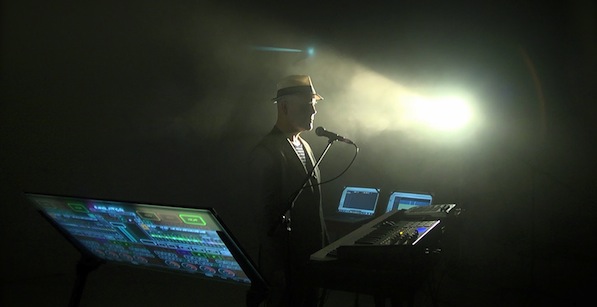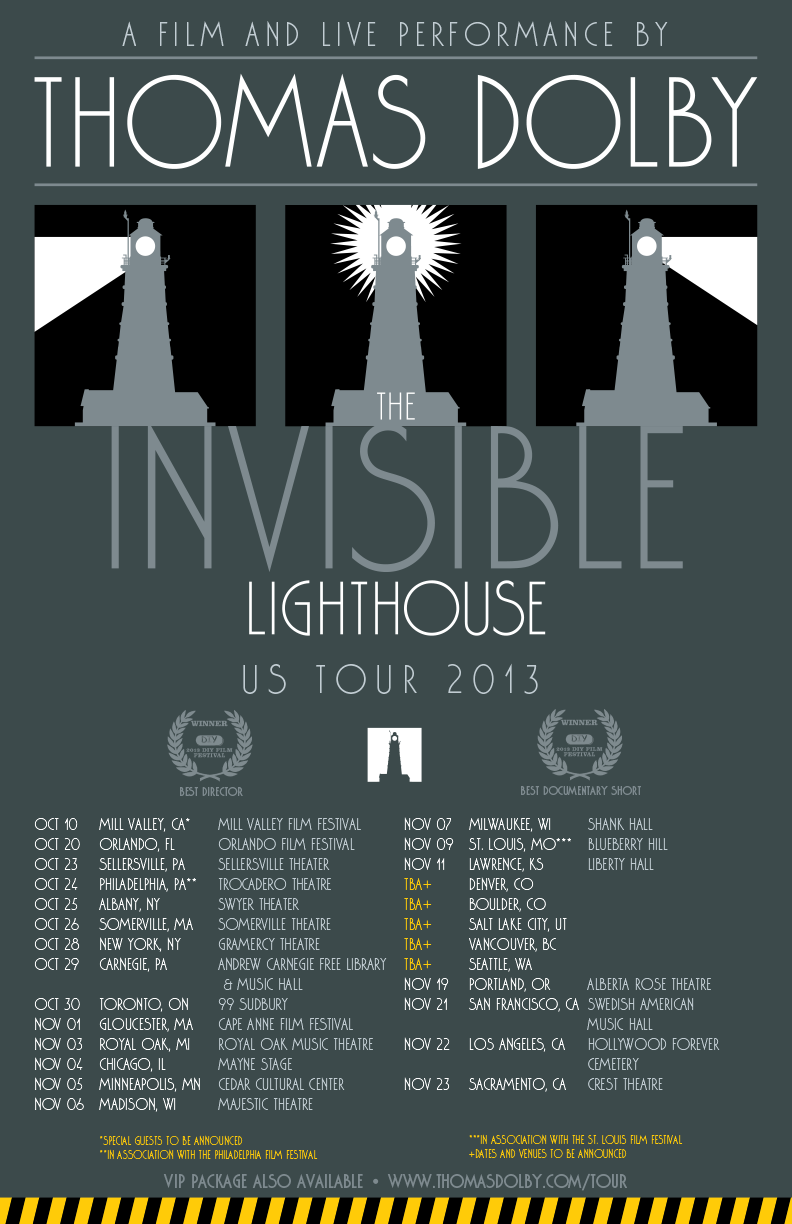Anyone familiar with the recent work of Sam Green and Brent Green (no relation) are aware of the remarkable potential of documentaries combined with live performance of both music, dialogue and foley. Thomas Dolby has now created something similar yet fundamentally different in The Invisible Lighthouse, which is now touring the United States and Canada over the next half-dozen months. Dolby’s debut film, a thirty-minute personal (and immensely humorous) documentary about his childhood, his family and his return to the area where he grew up, has a particular advantage in dealing with things remembered in his use of music throughout his career which has the effect of conjuring similar memories-of-times-past in the audience. Dolby also has the advantage of current technology that allows the filming of an eminent closing of a lighthouse to occur within a limited budget without shirking on stunning visuals or the dramatic tension (largely invented) of the situation. The film, alone, is definitely worth seeing. The tour, however, is something else altogether. Or, as the press release claims, this show is “Part Film, Part Concert, ALL Transmedia Event.”
The following conversation occurred at the Mill Valley Film Festival a few minutes ahead of the first performance of the tour (which included a once-in-a-lifetime short set from an all-star band: Dolby along with Dan Hicks [including a cover of Hicks’ “I Scare Myself,” which Dolby included on his second album, The Flat Earth], Don Was, Narada Michael Walden, Zoe Keating and Blake Leyh). Many thanks to Stephanie Clarke for coordinating the interview (as well as producing the show with Clare Wasserman) along with everyone else behind the scenes who allowed this conversation to occur: Julie Arkenstone, Karen Larsen and Vince Johnson, in particular.
Jonathan Marlow: When we last talked at SXSW in 2007, I mentioned something that probably is more prescient than I expected. Many, many years ago my brother and I spent a lot of time watching (repeatedly) Live Wireless. I believe it is one the great concert films of all time.
Thomas Dolby: Hmmm.
Marlow: There is an intersection between the concert and the notion that the performance isn’t really happening but is a projection of something filmed in advance. It was clear that you have a cinematic sensibility. Now you’ve proven it.
Dolby: I feel that—in some ways—my music is very somatic. It is evocative and the soundscape that I use hopefully conjures up pictures. There are times when I’m reluctant to put any kind of visuals to the music because then you’re replacing whatever picture is being conjured up in individual’s minds with something and saying, ‘This is the way it is supposed to look.’ Invariably, given that it is not really my medium, it would always be a compromise of some sort. In the case of both Live Wireless and The Invisible Lighthouse, I almost see them as ‘making of’ types of things. In both cases, they’re fictional but they provide a background to the songs.
Marlow: They create their own meta‑narrative.
Dolby: Yes.
Marlow: In a sense, The Golden Age of Wireless is a concept album but very loosely constructed around a theme. Live Wireless did not make an effort to recreate that. It just added something completely different on top of it. From what I know about what we’re about to see, you’re doing something very similar. As an artist, you have always been an innovator. You’ve always been a bit ahead of the curve, as it were. If you can call it a curve. With the expense of creating work visually and editing work—and being able to do that on your own rather than having to go out, raise a bunch of money to do it and hire somebody else to cut it together—you can independently realize whatever you would want to create. It is something unique to this particular time. And it is something that many others will be doing soon enough. It is as if you’re saying, ‘Look, there is a whole other possibility of how this can be done.’
Dolby: Yes. I think there’s a pattern to the things that I’ve done. There’s a breakthrough instrument or technology or app or software or business model that is still undefined but has become possible through progress. What I often do is dive in there and get my hands dirty and find ways to express myself with this new medium and see what happens. I’ve done that over the years with synthesizers, with drum machines and samplers and sequencers and then computers, which were all new ways to make music. New strings to the bow for a musician. I did it with music video in the old days of MTV. I did it when I went to Silicon Valley. I was able to actually start getting my hands on the software and writing my own and working with programmers and programming sound-game engines and things like that. Then the Web, when it came along, there was no sound on the Web to begin with. But the right way to do sound on the Web, it seemed to me, was not just in a linear sense because that’s not what the Web was. It was something that was happening in real time that was exciting. You weren’t just following a linear arc. You could poke at things. You could make it your own. That was the appeal of the Web. I felt the music could work the same way. In fact, you could have a flexible musical structure behind a linear front-end where there’d be music happening in the background but that is actually being affected by choices that the user makes. That was my goal in Silicon Valley. That probably would have fizzled out but, instead, it segued into mobile phones. It happened pretty much by accident. I can’t really take any claim for it. We’d made this synthesizer that was really tiny and worked in software. It happened to be exactly what Nokia needed to do polyphonic ringtones because other synthesizers that were out there were designed to be big. As big as your computer could be. Ours was designed to be tiny so it would be transparent when you loaded it into the webpage. It was exactly what they needed. But that was a business that, unlike the Web, actually had some teeth. Had some revenue. The second phase of my Silicon Valley career was in the mobile phone area. But, as a consequence, my whole Silicon Valley experience went on a lot longer than it was supposed to. It kept me away from music.
Marlow: Running a company [Headspace and Beatnik].
Dolby: Yes, running a company. By the time I got back to the U.K. I was really ready to kick back a little bit and do some music and let it all flow organically. I’d been away for so long that there was no concept of trying to follow on the hit formula that I had before or anything like that. The continuity that was there was really interesting. There was this hardcore audience that had been annotating chord sequences and interpreting lyrics and doing tribute covers, making their own CDs and even writing scripts where they would create expository stories for the characters in my songs or things mentioned in the songs. Fan fiction or something like that.
Marlow: These are folks from the Flat Earth Society?
Dolby: Yes. Through its various incarnations, there were forums and so on. That had followed the growth of the Internet. What was really interesting to me was that this was the stuff that mattered to me (rather than radio hits or whatever).
Marlow: Right.
Dolby: It was very gratifying to find that this was what they wanted. It’s a roundabout way of saying that—when I came out to England—I made an album. I made a game (and that was a way to wrap my arms around this fan fiction stuff and create an environment for them). Then, with the lighthouse closing, I thought, ‘Well, okay. I’ve done an album. I’ve done a game. How about a new medium? How about learning a new skill?’ So I thought of film because the breakthrough technology in that area was, with affordable high-end cameras, you can make professional stuff on your own. That was what I decided to do. I decided to document this lighthouse closure. What it turned into was an examination of my childhood, my memories, the legacy from my parents who were from the area, the legacy I’m handing to my kids who I brought back to that area to experience it, reflected in this landmark there which I’ve known all my life—this lighthouse which, now, is no more. It’s like a rite of passage to have something that is so important to you from your childhood fall off the face of the map and to become okay with that. That’s a really hard thing to do.
Marlow: You’re describing this somewhat as an opportunist, as if the closure [of the lighthouse] is a catalyst. But all of these opportunities are things that are, again, forward-looking. It is a convergence of technology and opportunity.
Dolby: Yes. In each case, what it has led to is a new type of expression for an artist. The innovation is not with the use of technology because there are other people fiddling around with it. The innovation is that—as an artist—I’m finding a way to express myself through this.
Marlow: I’ll let you go. But the last thing that I wanted to say is something that I think is consistent in all of this. You suggest you’re a bystander to these things in the way that you’re describing them. But when you listen to everything you’ve done it both evokes the period in which it was made and outside of the period. Most everything else from, for instance, 1982 (your first album) or 1984 (your second) seems instantly dated. But there’s something about the fact that you’re using instrumentation and technology in a way that is outside of the moment that makes it timeless. I hope that is what The Invisible Lighthouse will be.
Dolby: I hope so.
Marlow: You have a two‑month tour. Good luck.
Dolby: Thank you very much.
Marlow: You’ve done this a couple of times.
Dolby: I’ve done it on my own in England and twice with Blake [Leyh], who is my foley guy. This is the first U.S. one. It is the first time it’s all come together in one place, really.
Marlow: You have a knack for picking remarkable collaborators.
The Invisible Lighthouse live dates:
Sun., 20-Oct. ORLANDO, FL Orlando Film Festival
Wed., 23-Oct. SELLERSVILLE, PA Sellersville Theater
Thurs., 24-Oct. PHILADELPHIA, PA The Trocadero Theatre in association with the Philadelphia Film Festival
Fri., 25-Oct. ALBANY, NY Swyer Theater
Sat., 26-Oct. SOMERVILLE, MA Somerville Theatre
Mon., 28-Oct. NEW YORK, NY Gramercy Theatre
Tues., 29-Oct. CARNEGIE, PA Andrew Carnegie Free Library and Music Hall
Wed., 30-Oct. TORONTO, ON 99 Sudbury
Fri., 1-Nov. GLOUCESTER, MA Cape Anne Film Festival
Sun., 3-Nov. ROYAL OAK, MI Royal Oak Music Theatre
Mon., 4-Nov. CHICAGO, IL Mayne Stage
Tues., 5-Nov. MINNEAPOLIS, MN Cedar Cultural Center
Wed., 6-Nov. MADISON, WI Majestic Theatre
Thurs., 7-Nov. MILWAUKEE, WI Shank Hall
Sat., 9-Nov. ST LOUIS, MO Blueberry Hill in association with the St. Louis Film Festival
Mon., 11-Nov. LAWRENCE, KS Liberty Hall
Wed., 13-Nov. BOULDER, CO The Dairy Center for the Arts
Thurs. 14-Nov. DENVER, CO Bluebird Theatre
Mon., 18-Nov. SEATTLE, WA Showbox at the Market
Tues., 19-Nov. PORTLAND, OR Alberta Rose Theater
Fri., 22-Nov. LOS ANGELES, CA Hollywood Forever Cemetery
Sat., 23-Nov. SACRAMENTO, CA Crest Theater





